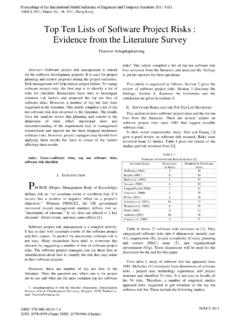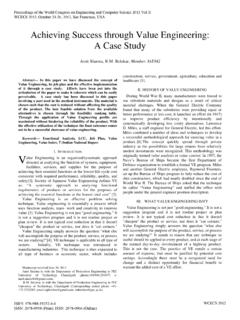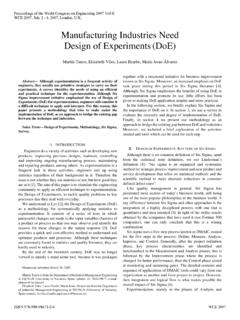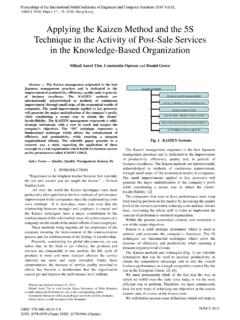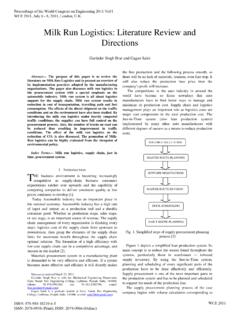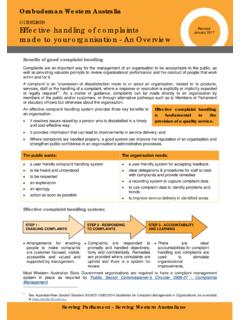Transcription of Strategic Information Systems Planning (SISP)
1 Abstract Strategic Information Systems Planning (SISP) is an important activity for helping organization to identify Strategic applications and to align an organization s strategy with effective Information Systems to achieve organization s objectives. Today, improved Strategic Information Systems Planning is the most critical issue facing Information Systems . Strategic Information Systems Planning plays a major role that makes huge contributions to businesses and other organizations. In this paper, an overview of Strategic Information Systems Planning including its importance , stages, and success are presented.
2 Index Terms Information Systems Planning , Strategic Information Systems Planning , Strategic Planning . I. INTRODUCTION Over the last decade we have seen an increase in recognition of IT and the more integrated role IT has begun to play in the strategy of organizations. The usage of modern Information technologies in the organization management will be successful only if Information system development is aligned with the organization system development strategy. This regarded as the Strategic Information Systems Planning (SISP) [1]. The nature of Information Systems in today s organizations coupled with raised pressure to leverage technology assets has raised the importance of SISP.
3 It is a key concern facing top organizations and Information Systems executives. SISP is a process used by organizations to integrate long-range use of applications to further their purposes, has become the most critical issue facing executives today. Lederer and Sethi define SISP as the process of identifying a portfolio of computer-based applications to assist an organization in executing its business plans and realizing its business goals [2]. Effective SISP can help organizations to use Information Systems to reach their goals and objectives. It can also enable organizations to use Information Systems to significantly affect their strategies.
4 However, the failure of SISP can result both in lost opportunities and the waste of expensive Information Systems resources. Manuscript received July 08, 2014; revised July 25, 2014. Arwa A. Altameem is with King Saud University, Riyadh, Saudi Arabia ( e-mail: Abeer I. Aldrees is with King Saud University, Riyadh, Saudi Arabia ( e-mail: aaldrees@ ). Nuha A. Alsaeed is with the Saudi Commission for Tourism and Antiquities, Riyadh, Saudi Arabia (e-mail: II. PROCEDURE THE Strategic ROLE OF Information Systems Information Systems have assumed an increasingly Strategic role in organizations. It helps organizations to conduct their daily activities, functions properly (accurately and timely manner with the help of software) , and supports decision making [3].))
5 Information Systems can be regarded as a Strategic resource in an organization. The opportunities can be classified in 4 areas: To gain competitive advantage. To improve productivity and performance. To enable new ways of managing and organizing. To develop new businesses. This is not to say, however, that all Strategic Systems provide an organization with an advantage. As a system can be strategically important for different reasons it can be a source of competitive advantage or it can be a Strategic necessity. All Strategic Systems become Strategic necessities as in an evolutionary theory of Strategic development [4]. Strategic role is helpful for the Planning of the organization because through Strategic role the future will be planned [3].
6 This expanding role has forced Strategic Systems planners to change the scope, objectives, style and sources of expertise in Planning . III. THE NEED FOR Strategic Information Systems Planning Since the 1980s, SISP has come to be one of the most important steps in successful introduction and optimization of technology in organizations. Although most literature reviews state that the success of any Information System is directly related to SISP. It was previously the work of technology and Systems professionals. It became changed to be a collaborative Planning challenge of parties (managers, business unit managers, technology and Systems professionals, and sometimes external stakeholders) [5].
7 In an organization, SISP can bring Information Systems users and Information Systems professionals together and establish a mutual understanding of the value of Information Systems and the problems associated with them. SISP can help organizations to develop priorities for Information Systems development by ranking such Systems in terms of their efficiency, effectiveness, and Strategic value. Effective SISP can assist organizations in using Information Systems Strategic Information Systems Planning (SISP) Arwa A. Altameem , Abeer I. Aldrees and Nuha A. Alsaeed Proceedings of the World Congress on Engineering and Computer Science 2014 Vol I WCECS 2014, 22-24 October, 2014, San Francisco, USAISBN: 978-988-19252-0-6 ISSN: 2078-0958 (Print); ISSN: 2078-0966 (Online)WCECS 2014 so as to reach their objectives and enable organizations to significantly impact their strategies.
8 It provides guidance on how the Information Systems infrastructure of the organization should be developed over time. It also ensures better use of Information Systems resources, including funds, Information Systems personnel, and time for scheduling specific project [6]. SISP can assist organizations in perfect (the best) and new ways to build barriers against new entrants, change the basis of competition, generate new products, use the most cost-effective methods or strike a balance between the powers of the suppliers [7]. SISP also ensures that whenever new Systems are build they can communicate or interface properly with pre-existing Systems .
9 It ensures that the Information Systems infrastructure is consistent with the Strategic vision of the organization. The success, and even survival, of an organization in today s markets is largely dependent upon the development and implementation of a coherent and innovative Strategic Information Systems plan. IV. SISP PHASES While much has been written about SISP, the important aspect that has been underemphasized is the Planning process or how Planning is accomplished. SISP planners have to consider the preparatory steps that ensure that business, organizational and Information strategies are aligned in a complementary fashion.
10 The overall role of technology and Information Systems within the organization must be determined, and the internal and external assessments need to be addressed. The most important point to remember is that the SISP process must be part of the overall organization plan [8]. SISP has been described in terms of phases and the specific tasks within them. The phases and tasks represent the components of the Planning process, with each having its own objectives, participants, preconditions, products, and techniques. The phases and tasks can be used to describe an organization s attempts to be comprehensive in its Strategic Planning process [9].
